When the Bridges of Paris Ran Red with Algerian Blood
In 1961, when a group of Muslim protestors marched against a controversial government-imposed curfew, the police responded — by beating them to death, then dumping their bodies in the Seine.

Photo by Daniele Darolle/Sygma via Getty Images
They emerged into the night from Metro stations across Paris. They alighted from commuter buses along the city’s fringes. Men in sport coats and ties. Women in long coats, in short skirts, in headscarves. Old men in berets. Young children, barelegged, on parents’ shoulders. Some were linked arm-in-arm. Some carried signs. Some chanted as they marched down the streets in what was to be a peaceful protest.
October 17, 1961 was a chilly night, a quarter moon hiding behind gathering clouds. Dark skies threatened rain. “If I come back, so be it,” one man told his wife, sensing the danger that awaited as he headed out, in defiance of the law, to join fellow Algerians on the streets. “If not, goodbye.”
Like many others, he did not come back, but his widow would share his tale decades later in Ici On Noie Les Algeriens, a 2011 documentary about the incident by French director Yasmina Adi. What would happen on this night would recall France’s darkes…
Keep reading with a 7-day free trial
Subscribe to Narratively to keep reading this post and get 7 days of free access to the full post archives.



